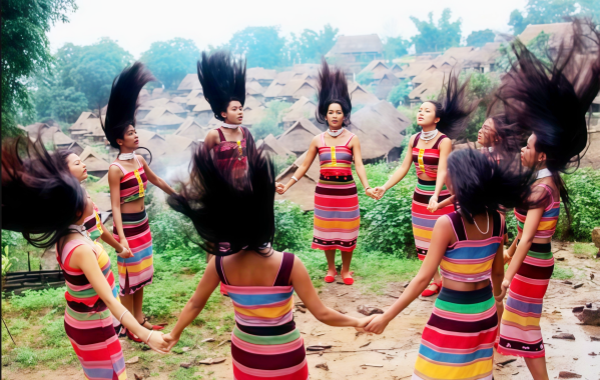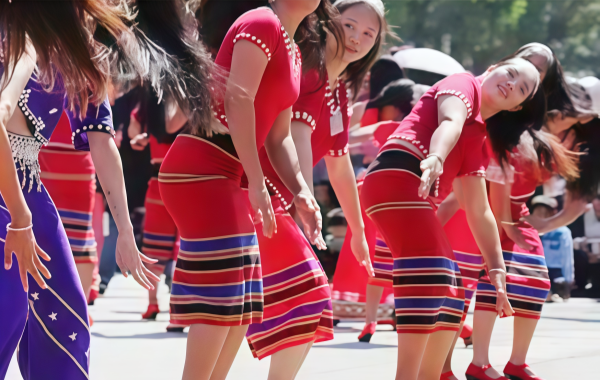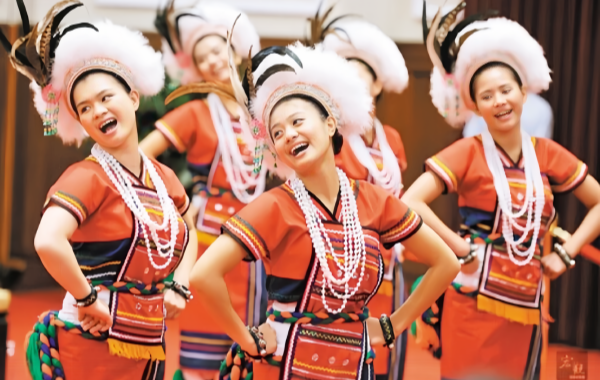Gaoshan
Introduction

The Gaoshan Nationality is a unique and culturally rich ethnic group in China. With a long - standing history and a diverse set of cultural traditions, the Gaoshan people have developed a distinctive way of life that reflects their close relationship with the natural environment of Taiwan. Their cultural heritage is an integral part of China's diverse ethnic tapestry, contributing to the country's cultural diversity and richness.
 History
History
· Origin
The ancestors of the Gaoshan people are believed to have migrated to Taiwan from Southeast Asia and the Pacific islands over thousands of years ago. Archaeological evidence shows that they have been living in Taiwan since ancient times, adapting to the island's diverse geographical and ecological conditions. Over time, they gradually formed different subgroups, each with its own unique cultural characteristics.
· Development
Historically, the Gaoshan people mainly engaged in subsistence agriculture, hunting, and fishing. They cultivated crops such as rice, millet, and sweet potatoes in the valleys and plains, and hunted wild animals and gathered fruits and nuts in the forests. Fishing was also an important economic activity, especially for those living along the coast. The Gaoshan society had a relatively simple social structure, with the village as the basic unit. Family and clan ties played a crucial role in social organization, and they developed a set of social norms and customs that were passed down through generations.
· Modern Times
In modern times, with the development of Taiwan's economy and increased interaction with the outside world, the Gaoshan people have experienced significant changes. The government has implemented various policies to promote economic development in Gaoshan - inhabited areas, improving infrastructure such as roads, schools, and medical facilities. Education has been greatly improved, leading to a higher literacy rate among the Gaoshan people. At the same time, efforts have been made to preserve and promote Gaoshan culture, including language, traditional music, dance, and crafts.
 Population
Population
· Quantity
As of the 7th National Population Census in 2020, the Gaoshan population in China is approximately 56,914, making them one of the smaller ethnic minorities in the country.
· Distribution
The majority of the Gaoshan people live in Taiwan Province, scattered across various mountainous and coastal areas. Different subgroups of the Gaoshan people have their own specific habitats. For example, the Amis people mainly live along the east coast of Taiwan, while the Atayal people are concentrated in the central mountain range. A small number of Gaoshan people have migrated to mainland China for work, study, or marriage, contributing to cultural exchange and integration between Taiwan and the mainland.
 Economy
Economy
· Traditional Economy
Traditionally, the Gaoshan economy was based on agriculture, hunting, and fishing. Agriculture mainly focused on the cultivation of staple crops such as rice and millet in the fertile valleys. Hunting was an important way to obtain meat and animal skins, and the Gaoshan people had developed rich knowledge of the local wildlife and hunting techniques. Fishing was carried out in rivers, lakes, and the sea, providing a source of protein and other seafood. In addition, the Gaoshan people also engaged in handicrafts, such as weaving, pottery - making, and wood - carving, which were used for daily life and cultural expressions.
· Modern Economy
In modern times, the Gaoshan economy has diversified. Agriculture remains an important sector, but there has been an increase in the cultivation of high - value crops such as tea, fruits, and flowers. Tourism has emerged as a growing industry in Gaoshan - inhabited areas, especially in those with beautiful natural landscapes and unique cultural attractions. Many Gaoshan people are involved in the tourism industry, offering services such as homestays, guiding, and cultural performances. Handicrafts, including traditional Gaoshan weaving and wood - carving products, are also important sources of income for some Gaoshan artisans. Additionally, some Gaoshan people work in the service sector, manufacturing industry, and other modern economic fields.
 Culture
Culture
· Language and Script
The Gaoshan languages belong to the Austronesian language family, and there are multiple dialects among different subgroups of the Gaoshan people. In the past, the Gaoshan people did not have a widely - used written script. In modern times, the Chinese characters are commonly used for writing, and efforts have been made to develop and promote Gaoshan - language writing systems to preserve and inherit the Gaoshan languages.
· Religious Beliefs
The Gaoshan people have a complex religious belief system. Animism is an important part of their religious life, and they believe that all natural objects, such as mountains, rivers, trees, and animals, have spirits. Ancestor worship is also deeply rooted in Gaoshan culture, and they hold regular rituals to honor their ancestors and seek their protection. Some Gaoshan people also embrace Christianity and Buddhism, which were introduced to Taiwan over the centuries. Religious activities are often closely related to festivals and important life events, providing spiritual support and a sense of community for the Gaoshan people.
 · Clothing
· Clothing
Traditional Gaoshan clothing is colorful and distinctive, reflecting the cultural characteristics of different subgroups. Women's clothing often features bright colors and intricate patterns. For example, the Amis women's traditional dress is usually made of colorful cloth, with decorative patterns such as geometric shapes and floral designs. They also wear a variety of accessories, including necklaces, earrings, and bracelets, which are often made of beads, shells, or silver. Men's clothing is relatively simple, typically consisting of a short - sleeved shirt and long trousers, often made of plain - colored cloth. In some special occasions, men may wear traditional hats made of feathers or animal skins.
· Literature
Gaoshan literature has a rich oral tradition, including folk tales, epics, proverbs, and songs. Folk tales are passed down from generation to generation through oral storytelling, often featuring animals as characters and conveying moral lessons. Epics are long narrative poems that recount the heroic deeds of ancestors or legendary figures, reflecting the history and values of the Gaoshan people. Proverbs are an important part of Gaoshan wisdom, providing concise and insightful expressions of life experiences and social norms. Gaoshan songs cover a wide range of topics, such as love, labor, and nature, and are often sung during festivals, social gatherings, and daily work.
· Transportation
In the past, due to the mountainous and island terrain of their habitats, the Gaoshan people mainly relied on walking for transportation. In some areas, they used boats for fishing and traveling along the coast or rivers. In modern times, with the development of infrastructure, motorcycles, cars, and buses have become common means of transportation in Gaoshan - inhabited areas. However, in some remote mountain villages, walking is still an important way of getting around, especially for accessing remote fields and forests.
 Science
Science
· Medicine
Traditional Gaoshan medicine has a long history and is based on the use of local herbs and plants. Gaoshan healers, known as "shamans" or "medicine men/women," have extensive knowledge of the medicinal properties of various plants and use them to treat a wide range of diseases. Traditional Gaoshan medicine also emphasizes the balance between the body, mind, and the environment, and the use of natural remedies is often accompanied by rituals and prayers. In recent years, there has been growing interest in integrating traditional Gaoshan medicine with modern healthcare systems to provide more comprehensive medical services for the Gaoshan people.
· Calendar
The Gaoshan people have their own traditional calendar, which is closely related to agricultural activities and natural phenomena. The calendar is used to determine the best times for planting, harvesting, and other agricultural tasks. It also marks important cultural events and festivals, helping the Gaoshan people to maintain their cultural traditions and sense of time. The traditional calendar is based on observations of the sun, moon, and stars, as well as the growth cycles of plants and the behavior of animals.
 Art
Art
· Music
Gaoshan music is characterized by its unique rhythms and melodies. Folk songs are an important form of Gaoshan music, covering a wide range of topics such as love, labor, and nature. Traditional Gaoshan musical instruments include the "nose flute," "mouth harp," and various types of drums. Gaoshan music often expresses the people's emotions and reflects their life experiences and cultural values. During festivals and celebrations, Gaoshan people gather together to sing and play music, creating a lively and festive atmosphere.
 · Dance
· Dance
Gaoshan dance is energetic and expressive, with movements that are closely related to daily life and work. Traditional Gaoshan dances include the "Harvest Dance," which depicts the scenes of farming and harvesting, and the "War Dance," which shows the bravery and strength of the Gaoshan people. Dancers wear colorful costumes and perform with enthusiasm, bringing people together in a joyful and harmonious way.
· Architecture
In the past, the Gaoshan people lived in different types of houses depending on their geographical location. Those living in the mountains often built wooden houses on slopes, using local materials such as wood and bamboo. These houses were usually divided into several rooms for different purposes, such as living, sleeping, and storing goods. The interior was simply furnished, with fireplaces for cooking and heating. Coastal Gaoshan people sometimes built houses using stones and coral reefs. In modern times, with the improvement of living standards, many Gaoshan people have moved into brick - and - concrete houses, but some traditional architectural elements are still preserved in some villages as a symbol of cultural heritage.
Landscape
The Gaoshan - inhabited areas in Taiwan are characterized by beautiful natural scenery, including towering mountains, deep valleys, clear rivers, and beautiful beaches. These areas are home to a wide range of plant and animal species, many of which are endemic to Taiwan. The beautiful natural scenery has inspired Gaoshan artists and poets for generations, and it also serves as an important ecological resource for the development of tourism and other industries.
Arts and Crafts
Gaoshan arts and crafts are renowned for their fine workmanship and unique designs. Traditional Gaoshan crafts include weaving, wood - carving, and pottery - making. Gaoshan weaving is often used to make clothing, hats, and bags, featuring intricate patterns and bright colors. Wood - carving products include statues, masks, and utensils, which are known for their exquisite craftsmanship and unique styles. Pottery - making products include pots, bowls, and vases, which are practical and decorative.
 Custom
Custom
· Etiquette
Gaoshan etiquette is based on hospitality, respect, and politeness. When guests arrive at a Gaoshan home, they are usually greeted warmly with a smile and a handshake. The host will offer tea or wine to the guests, and it is customary to accept these offerings as a sign of respect. During meals, guests are often served the best food, and it is polite to praise the host's hospitality. The Gaoshan people also place great importance on greetings, and young people should show proper respect to elders by using formal titles and polite language.
· Marriage Customs
Gaoshan marriage customs vary slightly from subgroup to subgroup but generally involve several steps. Marriages are often arranged by the families of the bride and groom, but the consent of the couple is also important. The engagement ceremony is an important step, during which the groom's family presents gifts to the bride's family. The wedding ceremony is a grand event that includes various traditional rituals, such as the exchange of gifts between the two families and the blessing of the newlyweds by elders. The wedding feast is a time for family and friends to gather and celebrate, with music, dancing, and delicious food.
 · Festivals
· Festivals
The Gaoshan people celebrate many important festivals throughout the year. The "Harvest Festival" is one of the most significant, which is held to celebrate the harvest and express gratitude to the gods and ancestors. During the festival, people gather together to sing, dance, and enjoy traditional Gaoshan food. They also offer sacrifices to the gods and ancestors, praying for good luck and a bumper harvest in the coming year. Other festivals include the "New Year Festival," the "Dragon Boat Festival," and the "Mid - Autumn Festival," which are celebrated in a similar way to the Han Chinese but with some unique Gaoshan customs and traditions.
· Diet
Gaoshan cuisine is characterized by its fresh ingredients and unique flavors. Staple foods include rice, millet, and sweet potatoes. Common dishes include grilled fish, stir - fried vegetables, and soups made with local herbs and wild mushrooms. The Gaoshan people have a tradition of using local ingredients to flavor their food, giving it a distinct taste. They also like to drink homemade wine, especially during festivals and social gatherings.
Funeral Customs
Gaoshan funeral customs are based on respect for the deceased and the belief in an afterlife. When a person dies, the family will hold a series of funeral rituals, including washing the body, dressing it in new clothes, and placing it in a coffin. Religious leaders or elders will perform prayers and rituals to guide the soul of the deceased to the afterlife. Family and friends will gather to pay their respects and offer condolences, and a funeral feast is held to honor the memory of the deceased. The mourning period varies depending on the relationship with the deceased, and relatives and friends will continue to offer support to the bereaved family during this time.
What Our Clients Say?
Based on 10,000+ traveler reviews











